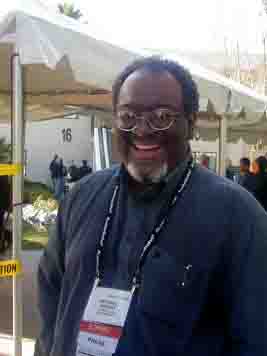Linn Klimax Kontrol Preamp
| Linn Klimax Kontrol Preamp |
|
Something Special |
|
Dave Thomas and Mike Wright |
|
December 2004 |

Not Another Brick In The Wall
I remember back in October of 1994 when Linn held a grand opening celebration of a new store in the trendy Lincoln Park neighborhood of Chicago. It was a great evening full of great people, great Scotch (of course) and lots of, as you can probably guess … great music. The evening went off without a hitch, save for one little ominous mishap. Linn’s enigmatic leader Ivor Tiefenbrun and about two dozen or so guests and well-wishers stood out in front of the building for the dedication of the new store. Ivor made a few pointed and humorous remarks, raised a bottle of champagne, smashed it against the corner of the building … and knocked out a huge chunk of concrete. The bottle didn’t have a scratch on it (apparently the bottle was made by Naim).
I had to a wee bit of “reality styling” with that story since it took place more than ten years ago, and frankly, my memory isn’t reliable past my last meal. Sadly, the Linn Store has long since closed. Maybe if products the caliber of the current Klimax series had been available, it might have lived to see the start of the new millennium. But one thing that I certainly will remember, at least as long as that story, is my time with the incredible Linn Klimax Kontrol preamp.
What Kind Of Mileage Does It Get?
Linn has long been one of high-end audio’s most admired companies, largely on the strength of their legendary yet still contemporary Sondek LP12 turntable (Is there anyone out there who calls himself an audiophile who hasn’t come across one of these tables?). Then a few years ago they set the audio world on its ear again with the awesome Sondek CD12 CD player. To be honest, I think the CD player initially caused more of a stir because of its $20,000 price tag than anything else. Heck when I first read the Stereophile review I wrote a letter to the editor complaining that they had forgotten to mention anything about the car that the CD player must have been built into.
Of course these days there are offerings from other companies that make the CD12 seem run-of-the-mill from a cost standpoint, sonically though, no one has surpassed it. The same may be said of the $9,999.00 Klimax Kontrol preamp. The first thing that struck me about this unit was that for such high cost it had a rather smallish chassis and was fairly simple looking. But once I touched that chassis and got a look at the massive learning remote control, I began to see where all of the money went. The unit comes housed in a sleek chassis that is machined from a solid slab of what looks and feels like a satin smooth silver aluminum. This chassis is designed to isolate and protects the circuitry. When you plug it in, it is immediately powered. There is no power button or on-off switch so the unit stays powered up. A STANDBY button is used to start and stop operation.
[And with the popularity of their CD 12, you may have thought that Linn had moved away from the delights of analog. Not hardly.]
Handling the Klimax Kontrol was a bit surprising in that not only is it very solid, but at nearly 20lbs., is fairly hefty as well. The front panel is elegant and deceptively minimalist. On the left side are three small soft-touch chrome-plated buttons: the standby button and two buttons for source selection. On the right are three more buttons: two for volume up and down and one for mute. In the middle of the faceplate is an elegantly styled black LED display. When powered up, the word LINN illuminates in a soft blue light.
The rear panel is where things really get interesting. Before I go any further, let me give you some advice. This unit is best used on the top or most easily accessible shelf. This is because of the low profile and awkward mirror image spacing of the left and right channel input and output connectors. Looking at the rear panel, the only set of connectors that are next to each other are the left and right RCA outputs and the RS232 outputs (for computer connecting), which are located beneath them. From there, the connectors for the remaining inputs and outputs are equally spaced from the center of the space between those RCA outputs. In other words, from the center of the space between the RCA outputs, the right XLR output is about 1.5” to the right and the left XLR output is abut 1.5” to the left. The XLR inputs (which comprise input 1) are spaced an additional inch to each side and so on for the remaining RCA inputs (which are numbered 2 thru 4). Other connections on the rear are for the KNEKT system and of course the mains input for which you can substitute the stock power cord (which is quite good) for any after-market cord that might fit. If you think this all sounds confusing just try hooking this thing up while it’s sitting inside of a middle shelf using only the tools of touch and feel. And heaven help you if you’re using stiff cables and power cord like I did at first. Not fun. But like everything else in this hobby, if you take the time to set the unit up correctly you won’t have any problems.
The unit’s learning remote (called the Linn Hi-Fi Personal Handset) is designed to run more than just the preamp. Though it looks like you could use it to land the space shuttle, it is actually designed to perform all of the tasks that you can perform manually using the preamp’s front panel buttons (e.g source selection and volume control) plus many more. At first, I tried to use the Handset as though it was just like all of the others that I had tossed around my listening room. But I soon remembered that I had all of technical acumen of a Bermuda squash and referred to the (thankfully, idiot-proof) owner’s manual (that you can actually download and read from Linn’s excellent website). But once again, here’s where all you’ll need is a little care and patience and you’ll be able to take advantage of some of the really neat features of this unit.
Inside the Klimax Kontrol is a testament to thoughtful design and some wonderful engineering, The first thing you’ll notice is a power supply that is actually called the “Brilliant Supply,” which provides silent power to the audio circuit board. The display and control boards are isolated from the audio board to keep the critical signal path clear. The result is an ultra-quiet control unit that gives you one of the cleanest, blackest, best-defined soundstages possible. As a neat personal touch, you’ll find the signature of the person who actually assembles, tests, and packs your unit on the bottom of the chassis.
Taking It For A Spin
After several weeks of trying the Linn out with different amp and speaker combos I finally decided that the best sound came when I paired the unit with my reference Electrocompaniet Nemos, Talon Peregrine X speakers and Virtual Dynamics Nite II series cables. The source component was my Electrocompaniet EMC1 CD player (used as a transport) connected to the wonderful Benchmark Media DAC1. The system was run fully balanced.
I gathered a selection of music that would benefit from a well-balanced system. First up to bat was Michel Jonasz’ “la fabuleuse histoire de Mister Swing” [WEA 2292-42338-2 II]. This is my tests disc for judging my system’s deep bass capabilities. Particularly the track “La Temps Passe.” This song showcases misseur Jonasz’ vocals with some highly synthesized neo-pop compositions that seemed to be extremely popular in many of the French nightclubs that I visited a few years ago. A lesser solid-state design would have made some of the synthesized crescendos sound bright and harsh, but the Linn made them bearable and to some degree even, dare I say, musical … All right, all right, I know the words synthesizer and musical don’t belong in the same sentence, but I’m just trying to illustrate how well the Linn makes even the unnatural sound natural. The Klimax Kontrol seemed to have absolute control of both extremes of the musical spectrum and if it can make this French disco-tune enjoyable imagine how it will reproduce a fine recording like Patricia Barber’s Live: A Fortnight In Paris [Blue Note]. Two tracks that really benefit from the eerily realistic imaging and spot-on musician placement that this unit is capable of are the frenetically paced “Whiteworld” and a really slick version of “Call Me.” Never mind Barber’s mono-toned vocal style and the fact that she can make even a fast-paced tune sound melancholy, the musicianship of her and her band is spectacular and the Klimax allows you to enjoy every nuance of it.
Fortnight In Paris [Blue Note]. Two tracks that really benefit from the eerily realistic imaging and spot-on musician placement that this unit is capable of are the frenetically paced “Whiteworld” and a really slick version of “Call Me.” Never mind Barber’s mono-toned vocal style and the fact that she can make even a fast-paced tune sound melancholy, the musicianship of her and her band is spectacular and the Klimax allows you to enjoy every nuance of it.
And with the popularity of their CD 12, you may have thought that Linn had moved away from the delights of analog. Not hardly. I fired up my trusty Magnum Dynalab FT101A FM tuner and was blown away by the level of life and musicality of a live FM broadcast and of the New Trier High School Symphony Orchestra no less! Of course the usual jazz fair afforded by WBEZ 91.5-FM, the local NPR affiliate, was also a joy to experience in the Linn-controlled system.
Conclusion
There’s not much to dislike about the Linn Klimax Kontrol … other than its ergonomics and price. And let’s face it, a person who can afford this beauty is also likely to be a person who can say, “The kids are all through college, the mortgage is finally paid off, and my 401k has cracked seven figures.” The person who won’t be lining up to buy one is probably saying, “The kids can’t spell college, I wish a was renting, and my 401k isn’t worth $401.” The fact is this piece would probably be a waste of talent in a system that did not meet its level of engineering and sophistication. So the components that will best round out a system with the Klimax Kontrol in it, are most likely to be components such as the $9,000 Linn Klimax Twin amplifier, the $45,000 Linn Komri loudspeakers, and of course the Linn Sondek CD12 … at $20,000.
Now that’s not to say that you shouldn’t consider the Klimax in a non-Linn system. It added another dimension of musicality to my reference system and pairing with the new $5,000 Classe Audio Delta Series CA 2200 amp, also yielded spectacular results. But the higher the caliber of your source components, amplification and speakers, the more sonic realism the Klimax will enable you to enjoy. It is simply the finest preamp I have ever used. Strongly recommended if you can afford it. If you can’t, try harder.
Mike Wright Chimes In
Linn Klimax Control: Back to prominence
 My-O’-My has Linn come a long way with their electronics. I remember when I first got into high-end audio, Linn, and their one-time cosmic twin Naim Audio, seemed to have this synergy between them. Linn was better known for its speakers and of course its turntable, and Naim was more focused on amps, preamps and crossovers. This seemed to work very well for a while, as together; they produced some of the most musical sounding systems that I (and many people) had heard. But alas, all good things must come to an end, and their parting of ways the was not particularly pretty. Linn dealers began pairing up the tables and speakers with American hi-fi components and Naim dealers began distancing themselves from the LP12 and began focusing more on its own digital front ends. As a result, Linn’s first couple of offerings into the electronics realm were not very well received and Naim’s digital front-ends produced a sound only a Naim enthusiast could love. In all honesty, I never took Linn’s amplification products very seriously … until now.
My-O’-My has Linn come a long way with their electronics. I remember when I first got into high-end audio, Linn, and their one-time cosmic twin Naim Audio, seemed to have this synergy between them. Linn was better known for its speakers and of course its turntable, and Naim was more focused on amps, preamps and crossovers. This seemed to work very well for a while, as together; they produced some of the most musical sounding systems that I (and many people) had heard. But alas, all good things must come to an end, and their parting of ways the was not particularly pretty. Linn dealers began pairing up the tables and speakers with American hi-fi components and Naim dealers began distancing themselves from the LP12 and began focusing more on its own digital front ends. As a result, Linn’s first couple of offerings into the electronics realm were not very well received and Naim’s digital front-ends produced a sound only a Naim enthusiast could love. In all honesty, I never took Linn’s amplification products very seriously … until now.
It was during last April’s Stereo Times “Most Wanted Components” awards ceremony that my interest in Linn was piqued again. Part of the entertainment at Ralph Glasgow’s gorgeous estate where the ceremony was held, was a complete Linn system playing some really great music. I came away with the impression that while the speakers may have had a difficult time filling Ralph’s rather large room, there was definitely something in the electronics worth investigating. I had heard about and read the glowing reviews of the Linn Unidisk CD player and Klimax Twin amplifier. So I figured that they must have really turned the corner with their electronics. So when DT asked if I would be interested in doing a follow-up to his review, I jumped on it.
A New Sound
The first thing that caught my attention was not only the musicality, but also how transparent the stage was. I felt that as far as stage height, width and depth goes, it was good, not great, but good. However, that transparency extended to the performers at the rear of the stage as well. The low-level resolution and detail and the sense of dimensionality and air around the performers caught my ear as well. I had to keep reminding myself that I was not listening to a tube preamp. Transient response was replicated realistically without any sort of edginess or rounding off of notes and the frequency extremes didn’t do anything to call attention themselves in a negative sense. More importantly, however was the portrayal of the music. I was just pulled deeper and deeper into the music. I kept watching the clock, knowing that I had to go to bed because I had to be up by 6:00am. I just couldn’t stop listening to music. One more track kept turning into one more CD and then began the vinyl adventures. Finally, 2:00am came around and I convinced myself that I could get by on four hours of sleep.
 My new favorite jazz group is The Dan Cray Trio. This is a Chicago area group consisting of childhood friends, drummer Greg Wyser-Pratte and bassist Clark Sommers, and Greg’s friend Dan Cray, whom knew he knew from Northwestern University. They all share a love and passion for jazz and it shows in their music. The energy and skill they put into their performances make the event all the more satisfying. On their CD, No Onemelodic tracks such as “The Lady is a Tramp” and “For All We Know,” show the group’s handling of standards, while the more up-tempo “Woody N’You” shows the drive and the energy the group plays with. Both types of selections were portrayed equally well through the Klimax Kontrol. The same was true of vocal performances.
My new favorite jazz group is The Dan Cray Trio. This is a Chicago area group consisting of childhood friends, drummer Greg Wyser-Pratte and bassist Clark Sommers, and Greg’s friend Dan Cray, whom knew he knew from Northwestern University. They all share a love and passion for jazz and it shows in their music. The energy and skill they put into their performances make the event all the more satisfying. On their CD, No Onemelodic tracks such as “The Lady is a Tramp” and “For All We Know,” show the group’s handling of standards, while the more up-tempo “Woody N’You” shows the drive and the energy the group plays with. Both types of selections were portrayed equally well through the Klimax Kontrol. The same was true of vocal performances.  On Jane Monheit’s CD, In the Sun, the tunes “It Never Entered My Mind” and “Haunted Heart”, had me emotionally transfixed on her voice. I could sense the emotion she was singing with while the Linn was in the system. I also enjoyed what the Linn did with male vocals as well. On the Dennis Rowland CD, Rhyme, Rhythm, and Reason, the track, “Don’t Misunderstand”, is one of my favorites. Mr. Rowland’s voice is a rich, full baritone and the Linn allowed me to feel his palpable presence and melodious voice, along with his accompanying band in my listening room.
On Jane Monheit’s CD, In the Sun, the tunes “It Never Entered My Mind” and “Haunted Heart”, had me emotionally transfixed on her voice. I could sense the emotion she was singing with while the Linn was in the system. I also enjoyed what the Linn did with male vocals as well. On the Dennis Rowland CD, Rhyme, Rhythm, and Reason, the track, “Don’t Misunderstand”, is one of my favorites. Mr. Rowland’s voice is a rich, full baritone and the Linn allowed me to feel his palpable presence and melodious voice, along with his accompanying band in my listening room.
Back near the head of the pack
I have been blessed to have some very, very nice preamps come my way. A great comparison for the Klimax Kontrol came by way of my own preamp, the Thor Mark II Linestage (review in the works). This was music at it’s finest with two of the best available preamps going at it toe to toe, both with their own set of strengths and weaknesses, that came out only when compared to each other. The Thor is definitely the more dynamic of the two. It has dynamics that are just explosive when called for. Those dynamics extend down into its bass performance, which is exemplary. The Klimax Kontrol’s bass is as good and maybe slightly deeper. The Thor’s bass may be fuller sounding, but it’s close. The Thor’s midrange has never sounded tubey but has always been neutral. You can ask anyone who’s been to my house and they will tell you the same. Next to the Klimax Kontrol, the Thor does sound ever so slightly to the warm side of neutral, which is not a bad thing and actually adds to the musical enjoyment. The high frequency performance was even more telling between these two. On dynamic speakers, both of these heavyweights sounded wonderful, with the Thor sounding a little more airy while the Klimax Kontrol had more detail. However, when listening to music on electrostatics, the Klimax Kontrol sounded as though it had as much high frequency extension as the Thor while maintaining a slight advantage in high frequency information. This is very slight and the Thor still satisfies, but the Linn just has something magical happening up there. There is just no way you could go wrong with either preamp. The Linn probably comes with a nicer remote control and though you can get a remote with the Thor, its not as substantial. No doubt, the ergonomics of the Thor will be a little easier for some to manage than with the Klimax Kontrol, but if that’s not going to be an issue for you then you’ll be fine. The Linn Klimax Kontrol is a great preamp whose performance is on par with their wonderful sounding CD player and amplifiers. I definitely missed it when DT came to take it away.
_______________
Specifications:
Input connectors
Unbalanced: 3 sets WBT Phono sockets
Balanced: 1 set Female XLR
Pin connections
Phono – Inner: hot; outer: cold
XLR- Pin 1: OV; Pin 2: Hot; Pin 3: Cold
Output connectors
Balanced: 1 set XLR
Unbalanced: 1 set WBT Phono sockets
Fuse rating
T800mA anti-surge
Mains supply range
100V – 240Vac nominal
Audio inputs
Impedance (unbalanced) 10KΩ
Signal (unbalanced) 0dBV (nominal)
Impedance (balanced) 7.8kΩ
Audio outputs
Impedance (unbalanced) 300Ω
Impedance (balanced) 600Ω
Gain range
Minimum to maximum -95.5dB to +9.5dB in 0.5dB steps
Frequency response
2.3Hz – 200kHz
Distortion (harmonic)
0.0025% (1kHz @ 0dBV)
Dynamic range
115dB
Cross talk
Channel to channel -116dBv
Source to source -116dBv
Standby power
15W
Dimensions
W 13.8 inches x D 13.9 inches x H 2.3 inches
Weight
19.84lbs
Price: $9,999.00
Address:
Linn Products
Telephone: 904-645-5242
Fax: 904-645-7275
Email: helpline@linninc.com
Website: www.linninc.com
![]()
Don’t forget to bookmark us! (CTRL-SHFT-D)
One thought on "Linn Klimax Kontrol Preamp"
Leave a Reply
Stereo Times Masthead
Publisher/Founder
Clement Perry
Editor
Dave Thomas
Senior Editors
Frank Alles, Mike Girardi, Russell Lichter, Terry London, Moreno Mitchell, Paul Szabady, Bill Wells, Mike Wright, and Stephen Yan,
Current Contributors
David Abramson, Tim Barrall, Dave Allison, Ron Cook, Lewis Dardick, John Hoffman, Dan Secula, Don Shaulis, Greg Simmons, Eric Teh, Greg Voth, Richard Willie, Ed Van Winkle, Rob Dockery, Richard Doron, and Daveed Turek
Site Management Clement Perry
Ad Designer: Martin Perry





Best preamp I ever listened to…and still all these tears later…I call it the best kept secret sleeper preamp of all time…🎶